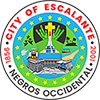HISTORY OF BARANGAY ALIMANGO
Barangay Alimango has been, since time immemorial, a swampy place that most of the areas especially on the southern portion near the Danao River would get flooded during rainy days and during high tides.
This unique terrain made it a natural habitat of crabs. During high tides, crabs would come in droves. Old timers claim they even climb up the houses of the residents. People then do not have to dig on the soft mud in the swamps to gather crabs for food or for sale. This abundance of crabs made the people call their place “Alimango”, the Cebuano term for crabs.
Enterprising residents have since cleared away much of the mangroves and built salt beds and fish ponds, which became one important source of livelihood of the people. One might say Alimango was built on salt beds and fishponds as it its local economy has grown because of it. As more areas were cleared for fishponds and salt beds, more lands were also cultivated into sugarcane. By 1960, the barangay was one of the important producers of solar-evaporated salt.
Its importance is its strategic position straddling the area between Old Poblacion and Danao Port and city center, Brgy. Balintawak. In 1956 the Municipal Council led by Mayor Amando Tambo assigned Atty. Santiago Yap to address the concerns of the barangay along with Udtongan and La-oyan.
As early as 1956, the municipality have been requesting fund assistance from the national and provincial governments for the construction of feeder roads, among them is the Alimango – Lawis road. Then Vice Mayor Ceferino Barredo donated a 1,000 square-meter lot (Title No. 29174 of Lot 1215-a) for communal nursery site. A 25 square-meter lot was given by Cecilia B. Clarin (Tax Dec. 7965 Lot No. 961. Romeo Torres donated a half-hectare lot to the Municipal Government.
In 1959, the barrio only had six (6) sitios: Libô, Lawis, Linao-1, Nabuta-an and Sombria. In 1967, the barangay and neighboring Old Poblacion were disputing over their boundaries since it impacts on their share of real estate taxes.
As a result of making Escalante part of the 1st Engineering District in June 22, 1963 (RA 3619), a sub-office of the then Bureau of Public Works and Communications was put up in an area, which has been since called simply as “Bureau”.
The annual fiesta used to be celebrated every 13th of June in honor of St. Anthony of Padua, their patron saint. It is now celebrated every June 30th.
The Alimango Elementary School was founded in 1930. It has a total land area of 1.6975 has. The Escalante National High School was founded in 1946. Both Don Manolo Lopez and Vicente Alemany donated about 3 hectares each for the school site. In 1965, the council urged for the renaming of Escalante High School to Francisco Ferrer Sr. Memorial School.
The Parents’-Teachers Association donated a schoolhouse to the Municipal Government in 1955. Additional funds were earmarked from the town coffers for the construction of school houses in the barangay.
The municipal council accepted the newly-constructed barrio hall in behalf of the barrio in 1962.
